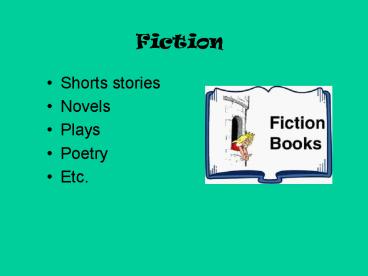Fiction PowerPoint PPT Presentation
1 / 19
Title: Fiction
1
Fiction
- Shorts stories
- Novels
- Plays
- Poetry
- Etc.
2
Definition of a Short Story
- Tells about a single event or experience
- Fictional (made up)
- 500 to 15,000 words in length (to be read in one
sitting) - It has a beginning, middle, and end
- Creates an impression on the reader
3
Definition of a Novel
- A novel is loosely defined as a long work of
fictional prose (Roberts and Jacobs 1622). - a novel has all of the fictional elements of a
short story. - The major difference is its length.
4
The Elements of Fiction
Every story has the elements of fiction whether
it is a short story, a novel, a play, a movie, or
even a television sit-com.
5
Point of View
the perspective from which the story is told
6
Two Points of View
- 1st Person everything you know about the story
comes from the narrators point of view who is a
character within the story. You dont know what
the other characters in the story are thinking,
saying, or doing when the narrator is not with
them. This is an easy one to pick out because of
the use of words such as I, me and my. The
first person narrator is often easy to trust
because you are listening to their version of the
story.
7
Characters
The people (or animals, things, etc. presented as
people) appearing in a literary work.
- 2 types
- 2 Dimensional flat characters that we dont
know very much about personally or emotionally. - 3 Dimensional we know what they are thinking
and feeling and they seem like real people to us.
8
Characters
- The protagonist is the main character.
- The antagonist is the person in conflict with the
main character. Not all stories have
antagonists.
9
all stories are built on conflict
10
Conflict
all stories are built on conflict
- Types of conflict
- Character vs. Character
- Character vs. Society
- Character vs. Nature
- Character vs. Self
- Character vs. the Supernatural
Conflict a problem in the story that needs to be
resolved.
11
Setting
- The Time and Place of the stories action
- The setting has several different functions in
the overall plan of the short story. It sets the
mood or atmosphere of the story, such as
romantic, scary, or depressing. In some stories,
the setting is important in shaping the
characters and events, but in other stories the
setting is not clear or even important to the
events of the story.
12
Atmosphere/Mood
- the overall feeling of a story.
- This can vary from dark to light, romantic to
comical, or suspenseful to peaceful. - The atmosphere is created by the words used to
describe the story.
13
Foreshadowing
- a method of creating suspense in a story. This
happens when the reader is given clues about what
is going to happen in a story before it actually
happens.
14
Theme
- The storys main ideas. The message the writer
intends to communicate by telling the story. - Stated themes are directly presented in a story.
- Implied themes must be inferred by considering
all the elements of a story and asking what
message about life is conveyed.
15
PLOT
- The plot of the story could be described as a
type of road map that the author gives us. - The main difference between the plot of a story
and a map is the fact that the reader may not
always know where the plot will take them.
16
A PLOT DIAGRAM shows how the main events in a
short story are organized into a plot.
17
- Exposition - The part of the plot that tells how
the story begins. Introduces the characters, the
setting, and the conflict - Rising Action - The action in the story leading
up to the climax. - Climax - The point of crisis in the plot. When
the action comes to its highest point of
conflict. It may be the readers point of highest
interest. - Falling Action - The action in the story after
the climax is revealed. - Resolution - The part of the plot that reveals
the final outcome.
18
Activity Exploring Plot 1
In this activity you will find the main events
in the fairy tale "Jack and the Beanstalk." Drag
each event to the appropriate point on the plot
diagram.
19
Activity Exploring Plot 2 In this
activity you will find the main events in the
fairy tale Cinderella." Drag each event to the
appropriate point on the plot diagram.

